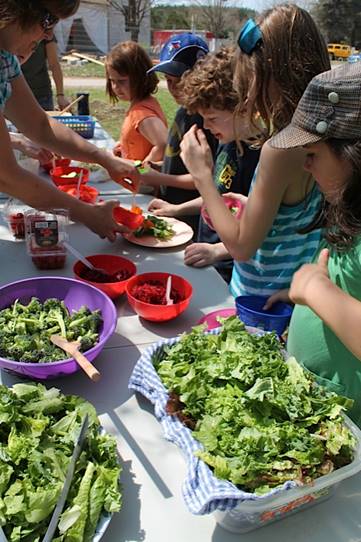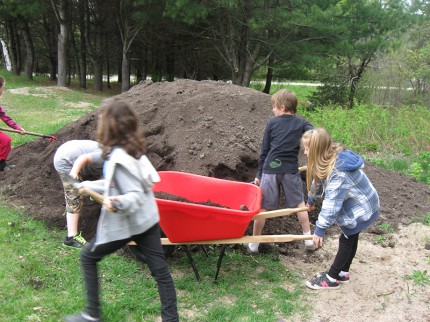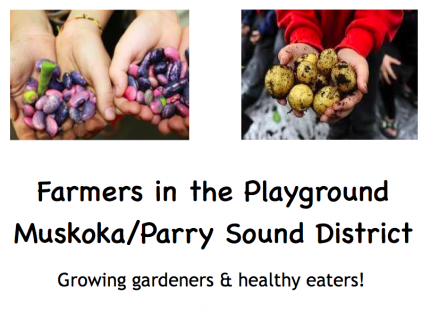Students Becoming Farmers in the Playground
Posted: November 11, 2014
Categories: Edible Education Network / Edible Education Project Profiles
 Farmers in the Playground (FiTP) is a kitchen and garden education program that currently runs in 3 schools in Muskoka and Parry Sound. The program connects kids to their food, working to turn the kids into educators themselves.
Farmers in the Playground (FiTP) is a kitchen and garden education program that currently runs in 3 schools in Muskoka and Parry Sound. The program connects kids to their food, working to turn the kids into educators themselves.
After 4 years of programming, Farmers in the Playground has seen students go home and grow complete food gardens with their families, and parents certainly seem to love having their children help in the kitchen and enjoying their vegetables. Kelli Ebbs, Farmers in the Playground Coordinator, says these are two outcomes that make the entire program worth every bit of work and perseverance.
Along with food garden facilitators, holistic nutritionists, farmers, parent volunteers and teachers, the little farmers build, plant and grow food gardens on their school grounds. Programs generally run for 10-12 weeks per year (snow cover permitted) and engage students one full day per week. FiTP usually works with a grade 3-4 curriculum to incorporate values and expectations into hands-on, experiential learning; however, in one school, the program has been adapted to serve various ages as an after-school program.
Each full day of programming consists of spending half of the day being active participants in garden stewardship – preparing beds, planting seeds, turning and moving compost, raking leaves for mulch, spreading straw, tending to the plants, building supports and trellises, painting signs, investigating soil and learning about bees and pollination. As you may recall from a previous profile we did with Farmers in the Playground, they’ve even raised their own meat chickens to eat!
This time, we dug deeper into the roots of the program and spoke with Kelli Ebbs about how FiTP came to fruition and some tips on getting started!
Tips from Kelli
- Ensure your programs are inclusive and open to all parents. Not only is the help a gift from the gods, but the skills you are teaching the students, you are also teaching them. You would not believe how many parents have told us that they have really changed or modified the way they look at and eat food in their own homes since learning from the program.
- Access as many pedagogical tools as you can from the world of food and garden education. Edible Schoolyard and Nourish are two very good ones but there are many!
- Keep kids engaged by encouraging tasting, nibbling, pulling out a carrot and wiping it on your pants to eat, and grow lots of herbs – they love fresh chives, they always try mint, lemon balm, basil, basically anything you grow they will try.
- Grow lots of early spring vegetables (this will depend on your climate), like kale, spinach, peas, rhubarb, asparagus (plant that ASAP as it takes 3 years to develop), haskap berries and herbs.
- Be very aware that you want the kids to experience and taste as much as possible while they are in school. The summer harvest benefits others but does not benefit the students who planted it as much.
- We now plant lettuce in the spring and then again in early August so they have lettuce when they return in September. Grow lots of root veggies, and other Fall harvest vegetables, and plant garlic – it’s one of the only planting activities in fall and it’s magical to see it coming up early in the spring time.
- Document what you do/harvest in the summer so you can show them in the fall.
- Grate and freeze zucchini, blanch and freeze beans, do whatever you can to preserve the bounty for fall time meals.
- Local gardening and horticulture groups may be able to help you out in the summer.
- Choose what grows well – we have experimented with some plants that just require too much attention in the summer and they just end up taking up space that roots and brassica’s could have used. Plant crops that will extend into the seasons as much as possible.
- Prepare fresh salads, introduce kids to funky veggies, and show the students how to make their own salad dressing – make sure you send them home with recipes or maybe even create ongoing recipe books through the year that they can finally take home.
Funding
We have been creative, have leveraged community buy-in and sponsorship, written and received many grants (written and NOT received many grants), have encouraged schools to find the funding on their own (successfully), have won some capital with community stewardship awards, and have worked as volunteers at least 50% of the time.
The nice thing about school garden projects is that once the infrastructure is developed (which doesn’t require huge amounts of capital), the only costs besides wages are soil amendments (occasionally), seeds (saving our own has been great learning and is a cost saver), trips to working farms and farmers’ markets, and food (if you are participating in kitchen education as well). FiTP is finding solutions in this field by working closely with The Muskoka North Good Food Co-op to partner and hopefully be able to leverage some revenue generation from their sales, which would be put towards maintaining current projects and growing future projects. Developers have huge dreams to create an urban centric farm on school grounds one day, and to also see a food garden in every school in the region.
Gaining Champions
A few things you really need to run a successful start-up project is a school principal and a school teacher who fundamentally believe in your mission and goals. It is a great idea to approach these two people with a great idea first. Discuss possibilities, outline curriculum integration (if that’s the direction you choose to go, and it will help leverage support in a school atmosphere), and look at some vague timelines. Once you have their support to move forward with more intensive development, draft an in-depth outline along with timelines and budgets to present. Immediately try to get onto the Parent Advisory Council agenda to introduce your plan – go with anything you want to ask (in writing) whether it is money (which they often have to contribute), fundraising ideas, leveraging volunteers (crucial), and their support for the program in general. They will be your link to disseminating information, pulling in volunteers at a moment’s notice, and to all school events you may want to have such as a spring garden festival, and school-wide harvest soup lunches.
Challenges
There are absolutely no challenges when it comes to student engagement, but be sure that adults who will be supervising, including teachers, have the time to do so, as this is a very hands-on initiative, which, if you have worked with kids (especially with garden tools and knives), requires all hands on deck. 
Summertime can also be a challenge. School is out so someone needs to tend to things. We try to set up a schedule with volunteers and parents – it benefits those people too because they can take veggies home through the summer. We were able to combine our food gardens at one school with 5 community garden plots (must get permission from the school) with the criteria that you help water, weed and harvest the school garden while playing in your own – no one seems to have a problem with that!
Succession Planning
The program has been such a success that we feel if we were able to offer it to every grade level at every school, they would take us up on it. There are many variations of the teachings that can be spread to engage 4-year-olds all the way to 17-year-olds. (If only there was universal funding for such a reality!) So, with that being said, one of the biggest lessons and observations we have learned is how well teachers who have been through our programs can deliver the lessons and skill building themselves – this really is key if your mission is to see this knowledge spread like chickweed!
All of the classes in the schools, at some point during the day or week, often come out, walk through the gardens, have meaningful discussions, draw and sketch. A couple of weeks ago, after our major harvest day, a large group of Junior Kindergarden students came out to have a tour through the garden to observe how different it looked and they ended up taking all the beans to their classroom, and shelled and dried them. They were fascinated by the various colours and designs of the beans – it was like Christmas every time they opened one. They especially loved the mottled pink and purple ones! We gave them enough to plant their own beans in their classroom in the spring – very cool to see!
Communication & Outreach
Start a Facebook Page and send home an invite to the page to all the parents. This is an exceptional way to share the day-to-day progress, post photos (ensure all students have their media consent forms signed), give updates of when and where your program will be running, lesson plans, and ask for volunteer participation. If you would like to bring a real chef to the program one day, you might just need to put it out there to your FB followers. Don’t forget that all schools require Criminal Records checks so you have to prepare in advance for that.
Check out this Slideshow Presentation Farmers in the Playground has provided us with, which includes many great pics from the program, more tips, and place-based results.
Contact:
Kelli Ebbs
Farmers in the Playground
farmersfeedus@hotmail.ca
This profile is part of a series of profiles for the Ontario Edible Education Network.
Be sure to check out more profiles from the Network here!

